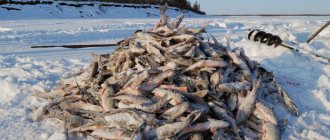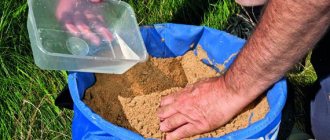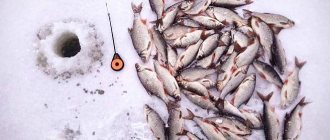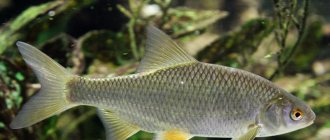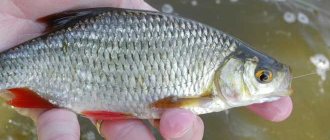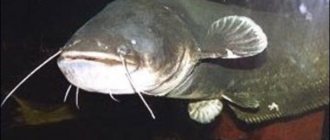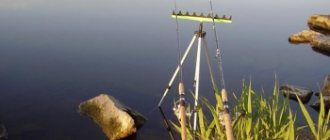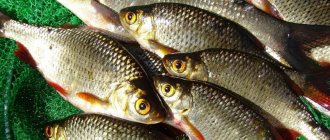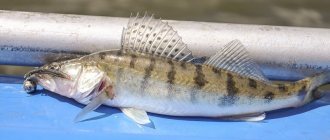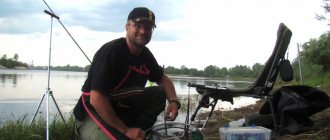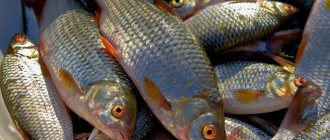Preparing the feeder for ramming
Fishing for rams is carried out mainly in places with slow currents on medium and small rivers, in creeks, lakes, etc. Taking this into account, a feeder rod for ramming is suitable with a test weight of 40 to 80 grams. In some cases, a picker with dough up to 40 grams will do. In general, the ideal option for catching rams would be light and medium parabolic fishing rods. Parabolic action means that the rod bends along its entire length. Among anglers they are commonly called noodles because of their excellent flexibility. Such fishing rods give great pleasure when landing fish and even when reeling in equipment.
If you fish in places with medium and strong currents, then you will need a feeder with a large dough of 100 grams and above, heavyweights. It is better to choose a softer rod and use a flexible tip with less dough. Many tips are marked with flexibility values in Lb. If there is no such designation, then you can bend each one a little with your fingers to understand which tips are more flexible and which are stiffer.
We set the reel with a spool size from 3000 to 4000. You can also set it to 2500 if the fishing distance is short. The reel should be light and not have unnecessary parts such as a baitrunner and elements that weigh it down.
We wind a fishing line on a reel with a diameter of 0.2 with a breaking load of up to 3 kg, or a braid with a diameter of 0.1 mm with approximately the same breaking load. We use any equipment: paternoster, inline and asymmetrical loop.
To do inline installation, you need to take a piece of fishing line with a diameter of 0.3 mm and first thread one stopper through it. After that we take a fastener like this
and thread it through the fishing line. After this we thread the second stopper. At one end of the fishing line we make a loop to which we attach a leash with a hook. At the second end we knit another swivel, which is fastened to the loop of the main fishing line. As a result, we should have a montage like this:
A more modified installation option looks like this:
As you can see, a swivel with a plastic eye is used, to which a twist is also attached, at the end of which a swivel for the feeder is attached. Thanks to this twist, the likelihood of tangling the feeder with the main fishing line is reduced.
If we use a paternoster, then it can be knitted on the main line. This reduces the likelihood of breakage of the equipment with the feeder. We knit leashes from fishing line with a diameter of 0.1-0.14 mm. We use hooks No. 14-18 according to international numbering. People with large fingers may find it difficult to knit such delicate rigs. The following tools help in this matter:
These are looper and hooker. From the names it is clear that we first knit the loops on the leashes and the main fishing line, and with the help of the second tool we tie the hooks. The loops are neat and of the same size, and with the help of a crochet hook you can tie even the smallest hooks of 20 numbers.
A few words about feeders. They are now sold in any fishing store. You can use both metal and plastic, with or without a bottom. When fishing for roach, it is better to use open-type feeders with a small volume. They look like this.
In this picture we see feeders of different sizes and different types. Any, but the smallest sizes are suitable for catching rams. The fact is that this fish, when active, takes the bait while falling. Therefore, it is better to feed less food, but more often. It is important that the food is dusty and consists of small particles. The more active the bait, the better. Closed feeders can only be used in strong currents. If the flow is slow, the feed will take a long time to wash out.
Catching rams in the spring: choosing gear.
Since we decided a little higher on the spring camp sites, choosing gear for spring fishing is no longer so difficult:
Now let's take a closer look at fishing with each tackle. So,
Catching rams in the spring gives a big catch to the fisherman
Float rod
The choice of fishing rod is traditional - as long as possible, comfortable, light, with a reel. Let me explain for beginners - a long rod makes it easier to cast over a longer distance. The reel will allow you to quickly adjust the length of the fishing line for optimally comfortable fishing. Catching rams in the spring involves a lot of transitions from one fishing spot to another. This is exactly what we justified the choice of light tackle.
The fishing line should be no more than 0.2 mm, use hooks No. 3 or even No. 4.
The choice of float depends on the weather - when the wind is strong, you should take a “heavier” float and adjust it so that the very tip sticks out of the water. In calm and quiet weather, you can take a lighter float.
Donka. We fish with bottom tackle.
Catching rams in the spring with a donk is not as interesting as with a float rod, but in some places you can catch larger specimens. Another advantage of choosing donks is easy long-distance casting. Despite the fact that in spring it is better to fish near the shore, there are situations when large schools stand at a distance. This is where the donka will come to the rescue. The choice of donkey type is not so important, and there are no special secrets to tell here, so let’s move on to the next tackle.
How to catch ram in the spring on a feeder.
Fishing with a feeder is more exciting than fishing with a donk, and they say that this is one of the most “catchable” tackles in the spring. So
If you are going to fish with a feeder, then think about how to equip it correctly. The length of the leashes should not exceed 50-55 mm.
For example, choosing a fishing rod - it’s better to stay at 350-400 mm in length. This will be quite optimal. The cord should be taken from 0.1-0.15 depending on the fishing location, bottom contamination, etc. You can use different hooks, from No. 8 to No. 20, depending on what you will be fishing with.
The weight of the feeders will be optimal in the range from 35 to 90 g. It will be convenient to use spring-type feeders. You can read further on how to fill them.
We equip a Bolognese fishing rod
We will need a light fishing rod made of graphite or carbon fiber, 5 meters long. The fishing rod should be flexible, parabolic type. On the reel seat we install an inertia-free reel with a spool volume of 1500 or 2000. We wind a fishing line on it with a thickness of 0.18 - 0.2 mm. We put one rubber stopper on the fishing line, then thread a swivel onto which we hang a sliding float. The tackle will look like this:
It is better to use a needle-type float with a load capacity of 2-3 grams. We don't need long casts, so the sensitivity of the float is a priority.
We tie the leash as usual - using the loop-to-loop method. You can also use a small swivel, as shown in the figure. The length of the leash is 7-10 cm. We use hook No. 14-20 according to international numbering.
Float tackle for ram
Ram is a fish that can be caught using any gear, including float gear. As a fishing rod, you can use almost forgotten bamboo blanks, or you can use more modern ones made from composite materials. Classic float tackle consists of:
Rod
As mentioned above, any rod will do. Its length can be about 4 meters and have a fast action. It is desirable that it be light.
Coil
As for the reel, the main condition is endurance and corrosion resistance, since you will have to deal with salt water. No power reel models should be installed on such tackle. The coil size can be in the range of 2000-3000. High-speed reels used on match rods are perfect.
fishing line
The main line can be selected with a diameter of no more than 0.12 mm in clear waters, and with a diameter of no more than 0.2 mm in the presence of algae. The thickness of the leash is in the range of 0.08-0.1 mm.
Float
Floats should be used with a keel if fishing is carried out at sea or in bad weather. The float must have good visual characteristics as well as stability characteristics. In fast current conditions, it is better to use floats that look like a ball or a drop. If there is no current, then floats with a long and thin bite indicator are suitable. Wagler type floats, which have one attachment point, have proven themselves well. It is very important to load the float correctly so that it is sensitive enough.
Hooks
Hooks are selected depending on the size of the fish. It is very important to have a special coating when fishing in salt water.
Equipping a fly rod
We will need a parabolic type fly rod 6-7 meters long. We tie a piece of fishing line to it, which is 30 centimeters longer than the rod. We attach the fishing line to a plastic connector located on the tip of the rod.
We install a sports float with a blind mount, teardrop-shaped or needle-shaped. The carrying capacity of the float is 1-2 grams. In quiet places and when fishing on a boat between water lilies and in creeks, you can use lighter floats.
We surround the floats with 3-5 pellets. The remaining elements of the equipment are the same as in the Bolognese fishing rod.
It is convenient to hold rigs for match fishing rods on plastic reels of this type:
It is better to have up to 10 such equipment. On the reels we write the diameter of the fishing line and leader, the hook number and the carrying capacity of the float. Upon arrival at the reservoir, we select the equipment that is applicable for the given conditions.
We equip a donk for catching rams
It is better to use a rod for bottom fishing for rams that is light and not long, up to 3.3 meters. A folding telescopic one or one consisting of two elbows and a top is suitable. We install a light reel on the fishing rod with a spool capacity of 3000 to 4000. You can also use an inertial reel of the following type:
We wind a fishing line with a diameter of 0.25 mm or a braid with a diameter of 0.12 mm on it. We attach the bottom equipment to the fishing line. It can consist of a flat weight or a sliding feeder. Bottom mountings on a ram look like this:
The rigs are knitted on a fishing line 0.3 mm thick. A leash made of fluorocarbon fishing line 0.2 mm thick is attached to a swivel, or loop to loop. Hooks are used Nos. 12-16 according to international numbering.
The following devices can be used as a bite alarm:
An alternative to such alarms can be classic bells or electronic alarms. If you use a sensitive fishing rod, then the bites are clearly visible at the tip, as on a feeder rod. Many fishermen do without alarms.
Follow us on social networks
— through them we publish a lot of interesting information, photos and videos.
Popular sections of the site:
The fisherman's calendar will allow you to understand how all the fish bite depending on the time of year and month.
The fishing gear page will tell you about many popular gear and devices for fishing.
Fishing baits - we describe in detail live, plant, artificial and unusual ones.
In the bait article you will get acquainted with the main types, as well as tactics for using them.
Learn all the fishing lures to become a real fisherman and learn how to choose the right one.
Successful catching of rams in the spring is the result of preparation
- Catching rams in the spring: choosing gear.
- Float rod
- Donka. We fish with bottom tackle.
- How to catch ram in the spring on a feeder.
- Nozzle
Spring is a wonderful time! Everything blossoms and comes to life, blossoms and, what is more important for us, begins the hunt! It is spring that fishermen associate with the beginning of a new fishing season. But a novice fisherman may have questions: who to catch in the spring? The most correct action would be to catch rams in the spring, which will smoothly transition into catching rams in the summer and autumn. In general, you can catch it all year round, but in the spring fishing will be especially interesting.
Ichthyology
In general, the ram cannot be called a sea fish; it lives only near desalinated outskirts and bays, and cannot tolerate water with a high concentration of salt. The most favorite places for Azov roach are:
Appearance
The ram differs from the common roach in several ways:
- taller body;
- small scales;
- the number of rays in the anal fin is 9-10;
- dark edges of paired feathers;
- thick teeth.
The ram grows up to 25-35 centimeters in length, with a body weight of up to two kilograms, although its commercial weight is usually 200-500 grams.
Spawning
Ram spawning occurs in March-April, when the water warms up to 7-10 degrees. Spawning occurs exclusively in the fresh water of numerous tributaries of the Azov and Black Seas. Mating games take place in shallow waters overgrown with aquatic vegetation, after which the weakened fish rolls back into the sea.
It should be noted that during spawning, fishing for rams is prohibited even with a float rod with one hook. This is being done to restore the population of this fish, which was previously caught so massively that it was literally sold by the cartload.
Nutrition
Just like other types of roach, the ram feeds on both plant and animal foods. The following food elements are found in her daily diet:
- filamentous algae;
- worms;
- shellfish;
- shoots of young plants;
- bloodworms and other insect larvae;
- small crustaceans.
The Black Sea roach is practically omnivorous and will always find food for itself.
Tackle
Catching rams is carried out by several types of gear, among which the most popular are:
- float rods of all types;
- donks, including the feeder;
- winter fishing rods.
In shallow estuaries, long-range gear is especially successful: a bottom feeder or a float match.
The equipment of these fishing rods with fishing lines is not very different, since rams that exceed half a kilogram are rarely found in catches, so the tackle should not be coarsened. It is quite enough to use a monofilament with a thickness of 0.12 millimeters as the main fishing line, and a leash of 0.08-0.10. These diameters can be slightly increased when fishing in heavy, strong places overgrown with dense vegetation.
Float rod
To catch rams with a float, three types of float rods are used:
- max – in narrow channels;
- lap dog - for longer casting;
- match - in sea estuaries.
All three types of fishing rods are loaded with spaced pellets so that the bait slowly sinks to the bottom when casting the tackle, even at this stage attracting the ram to bite.
In general, building a float tackle for catching Azov roach may look like this:
- The rod is telescopic or plug-in, 4-5 meters long.
- Lightweight inertia-free reel with a spool of no more than 2500 Shimano units.
- A fishing line with a diameter of 0.12-0.14 millimeters.
- A float with a keel, which is important when fishing in the current, in the sea or in strong winds.
- Several pellets with a padding.
- Hook according to the size of the bait.
Donkey
Catching rams with bottom gear is carried out both at the mouths of rivers and directly on the coastal areas of the seas. At the same time, its construction is also distinguished by the elegance and subtlety of its elements. Let's consider the equipment of the feeder for fishing for sea roach:
- The rod is 11-13 feet long. The longer the form, the longer-range it is, and the place where it is used depends on this.
- The reel is a spinning reel with a small spool.
- Braided or monofilament fishing line of small diameter, approximately 0.12 millimeters.
- The leash is 50-80 centimeters thick and 0.08-0.10 millimeters thick.
The equipment is performed at the end of the main fishing line directly while fishing. However, many fishermen prefer to do it themselves at home, so as not to waste time on the pond. The entire installation is done at home from a piece of rigid monofilament of 0.14-0.16 millimeters.
Recipe No. 1
This bait is used mainly in slow and medium currents when fishing with wire. It consists of the following components:
- Brain bait (Large roach) – 1 kg
- Boiled millet – 1 kg
- Breadcrumbs – 300 g.
- Biscuit cookies – 200 g.
- Chocolate or vanilla spray
Since the ram is a heat-loving fish, the bait should be sweetish and have a pleasant chocolate or vanilla smell. In warm water, odors spread better and fish find bait on the bottom faster.
We cook millet as usual: 2-2.5 glasses of water per glass of cereal. Cook for 8 minutes so that the grains are not completely cooked. The porridge is cooked and it may immediately seem that it is too liquid. You need to let it cool a little and absorb water. After several hours it will harden and become rubbery and elastic. It should be mixed well so that there are no lumps and add bait and crackers. After this, mix everything again and add the ground cookies. The result should be excellent bait that will quickly collect not only rams, but also silver bream and white bream at the bottom.
Pour the finished mixture into a special bag or bait bucket and put it in the refrigerator. This mixture is completely ready. In a pond, it should be slightly moistened with water and the mixture should be refreshed with a spray. Next we make small balls the size of a chicken egg and throw them into the fishing area. If we are fishing in the current with the wire, then we throw it a little to the left or to the right of the float, against the current.
Since fishing for rams involves constant casting, especially when fishing into the wire, one rod is quite enough. First, we throw 5-6 balls at the fishing point. Then every 15-20 minutes we add one ball.
It is very important to maintain a constant feeding rate, accustoming the fish to the fact that there is an inexhaustible supply of bait here. After the ball is thrown, a noticeable revival is observed and after a short time, as a rule, larger individuals sit on the hook. This pattern has been noticed by fishermen for a long time. That is why it is important to feed not a lot, but often. This bait is enough for a whole day of fishing. If not, then simply take the bread, mix it with soil and some kind of bulk, feed it with slightly smaller balls, but at the same pace.
Lures and bait
For both float and bottom fishing for rams, the same type of bait is used. The following are used as baits:
- steamed cereal grains;
- bloodworm;
- dung and earthworms;
- maggot;
- dough;
- semolina chatter;
- bakery products.
Like all other carp fish, ram is very responsive to bait. For this, various grain mixtures are used with the inclusion of both large and dusty fractions, the main thing in which is invisibility on the bottom; sea roach is very wary of spots on the bottom that differ in color from the natural color.
Winter fishing
Catching rams in winter is carried out from freeze-up to melting ice. You can catch it either with a float rod or with a tackle with a nod and a jig.
The winter roach's mooring sites are the same as the common roach's habitats:
- eyebrows;
- steps and tubercles on the bottom;
- pits on the arrows of two streams;
- thickets of aquatic vegetation on the borders with clean water;
- snags and elements of hydraulic structures.
The most common fishing rods for catching rams from under the ice are used. They are equipped with the finest fishing line and a variety of jigs. The best bait in winter is bloodworms; in rare cases, fish gravitate towards a worm or maggot.
Secrets of catching roach in autumn
Fishing on small rivers has shown that roach prefers relatively deep places in the fall, sometimes staying under the bank, near vegetation. As for the current, the roach avoids too fast a stream, but stays in areas of turbulence, picking up food. So, the key to successful autumn fishing is the use of bait.
I recommend, 4-5 days before the planned fishing, to gradually feed the place where the fish are supposed to stay, “accustom” the fish to a certain time and place.
The composition of the bait may be different, but I definitely put in it, in addition to all sorts of plant components and oils (aromatic plant), and food bloodworms and worms. I add the animal component immediately before feeding. It is clear that fishing is carried out in the future, in most cases with worms and bloodworms. There have been no misses so far.
Further, when I choose a fishing spot in the fall, I give preference to areas covered with leaves. I noticed that in such places bites happen more often and the fish are larger. Since roach is a “capricious” fish, in the fall you need to carefully play with depth.
I do this: first I fish from the bottom. If there are bites, I continue further; if there is silence for 10-15 minutes, I reduce the descent by 1 cm, and so on. The goal is to find the layer of water where the roach is currently feeding. If you don’t do this, you can stand there all day and go home “empty.”
Taran (ram)
Taran, ram is the name of anadromous or semi-anadromous fish of the carp family. From the point of view of ichthyologists, this is a subspecies of roach of the Azov-Black Sea basin. It differs somewhat from the freshwater form in its taller body and larger size. Local fishermen often find many characteristics of the ram from other forms of roach. But the main difference from related subspecies, especially roach, is its residence in the Azov-Black Sea region. Due to the fact that the name - ram or roach, people often associate with dried fish, sometimes there is confusion in determining the type of fish. Sometimes you can find completely different fish on sale under this name, including bream and others. The dimensions of the ram can reach a length of more than 40 cm and a weight of about 1.8 kg. These fish enter rivers only for spawning and, as a rule, do not rise high upstream. During the spring run, there are massive fish kills; they are associated with changes in the water level in the river and weather conditions. The pre-spawning run of fish into rivers begins under the ice, so fishing can be very varied. Currently, a strong decrease in the number and size of the Azov population has been noticed. This is due to extreme forms of poaching (for example, uncontrolled hunting of juveniles - “talovirka”) and deterioration of the environmental situation, including changes in natural conditions on natural spawning grounds.
Recipe No. 2
This bait is designed for fishing rams in cold water. Unlike the previous mixture, it will not have such “sweet” smells. This mixture is used on rainy summer days and in autumn. It consists of the following ingredients:
- Groundbait for roach in cold water – 1 kg
- Rye crackers, fried – 0.5 kg
- Ground seeds – 300 g
- Ground hemp grains – 100 g.
- Feed bloodworm – 1 serving
- Liquid liquid for cold water – 200 g.
- Soil – 300g.
We pass the bait through a fine sieve to separate large elements. They can be ground or soaked and added to the finished mixture. Then pour out all the remaining bulk elements. When fishing, add soil and prepare balls. During the mixing process, add liquid aroma.
We add feed bloodworms in stages. We took some of the bait, added bloodworms to it, and made balls. We made a starter feed. After some time, we made the next batch with bloodworms and fed the fish. The pace is not the same as in summer, the bait works more slowly, it is designed for inactive fish.
Why can’t you add all the bloodworms at once? The fact is that many store-bought baits contain salt and other components that bloodworms cannot tolerate. He quickly dies in them. In the balls at the bottom, the bloodworm quickly separates and moves, collecting schools of fish.
The feeding tactics are as follows. Throw balls the size of tangerines exactly onto the floats. The starter feed consists of 50% of the entire bait mixture. After that, we look at how active the fish is. If the bite is good at first, and then it starts to deteriorate, then it’s time to throw in a few balls. During the fishing process, we ourselves select the frequency and amount of feeding.
When we fish in late autumn, it is very important not to overfeed the fish. If we see that the bite is unstable and not constant, then there is no need to throw balls often. Sometimes it makes sense to add more soil so that the bait is not so high in calories and does not quickly saturate the fish. To increase appetite, many fishermen add special molasses. The fish eat this food, but do not get completely full.
Methods for catching rams
Fish is of great commercial importance. Despite the shrinking and decreasing population, the massive movement of fish in the spring attracts a large number of amateur fishermen. Fishing for ram, as well as for roach on the Volga, is an exciting and challenging activity. For this, various gear is used: spinning rods, float and bottom fishing rods, fly fishing, “long casting” gear using artificial baits, winter fishing rods.
Catching rams with float tackle
Features of using float gear for catching rams depend on the fishing conditions and the experience of the fisherman. For coastal fishing for all types of roach, rods for “blind” equipment 5-6 m long are usually used. For long casts, match rods are used. The choice of equipment is very diverse and is limited by fishing conditions, and not by the type of fish. As in any float fishing, the most important element is the correctly selected bait and bait.
Catching rams with bottom tackle
Taran, like all types of roach, respond well to bottom tackle. Fishing with bottom fishing rods, including feeder and picker, is very convenient for most, even inexperienced fishermen. They allow the fisherman to be quite mobile on the reservoir, and, due to the possibility of targeted feeding, to quickly “collect” fish in a given place. Feeder and picker, as separate types of equipment, currently differ only in the length of the rod. The basis is the presence of a bait container-sinker (feeder) and replaceable tips on the rod. The tips change depending on the fishing conditions and the weight of the feeder used. The bait for fishing can be any bait, either of plant or animal origin, or paste. This fishing method is available to everyone. The tackle does not require additional accessories and specialized equipment. This allows you to fish in almost any body of water. It is worth paying attention to the choice of feeders in shape and size, as well as bait mixtures. This is due to the conditions of the reservoir (river, bay, etc.) and the food preferences of local fish.
Features of catching rams at different times of the year
In the spring, the ram begins to spawn very early, when the water warms up to a temperature of +7+10 degrees C. It does not spawn in sea waters, but goes into rivers, canals and bays. Here the water warms up better, as well as more vegetation, which will both protect and feed the offspring.
During the spawning period, in order to preserve the population, ram fishing, even amateur fishing, is prohibited by law, so there is no need to talk about spring hunting for this fish yet. Conscientious fishermen begin to catch ram only at the beginning of summer, when, hungry, it returns to the sea. The best places for hunting this fish in early summer are considered to be coastal thickets of reeds and water lilies, island channels, overgrown canals and estuaries.
In summer, the fish is very active and unpretentious in terms of feeding. It can be caught with almost any bait, from various cereals to an ordinary earthworm. But it is still preferable to use maggots, bloodworms, or combinations thereof.
Fishermen use both a regular float rod and various bottom devices to catch rams. But the most preferred tackle, of course, is the feeder.
In mid-summer, most of the fish go to sea waters, but the rest of them remain in fresh water. It is often called river ram. It does not go far upstream, but prefers to stay in the mouths.
In the sea, ram can be caught from mid-summer to mid-autumn. They catch it both from the shore and from a boat using various float and bottom gear. But sea ram hunting is not very popular among fishermen, since it is quite rare in salt water. In summer, she prefers plant food, but will never disdain a good “bouquet” of maggots. The only thing is that during this period the ram becomes more cautious and treats suspicious bait with caution.
In late autumn, sea rams again gather in large schools and rise into rivers and bays. Here she actively migrates in search of food, gaining fat before winter.
And when the first ice appears, the period of winter hunting for ram begins. She actively bites all winter. For ice fishing, anglers use a winter fishing rod, both with a jig and with float tackle.
Lures
As with roach, food plasticity is characteristic. Depending on the region and season, fish quickly adapt to local food sources. For fishing with bottom and float gear, traditional baits are used: animal and plant. For baits, worms, maggots, bloodworms, and various grains are used. It is very important to choose the right bait, to which animal components are added, if necessary. Various traditional lures are used for fly fishing. Most often, small flies are used on hooks No. 14 - 18, imitating familiar food for roaches: flying insects, as well as their larvae, in addition, underwater invertebrates and worms.
Tying the hook to the fishing line is an important step!
Another point that affects the implementation of bites is how the hook is tied to the fishing line.
If the hook has an eye and you tie it by this eye with a simple knot, then the hook in the water may take the wrong position. The fish may not be hooked; the hook will simply slip out of its mouth. Therefore, it is better to secure the hook with a universal knot. A few turns of the line around the shank securely attaches the hook to the line.
Spawning
Taran, like roach, becomes sexually mature at 3-4 years. Spawns 5-6 times in life. The fish begin to spawn under the ice. The mass move occurs just before spawning, which occurs in late March-April. The fish is stuffed into various branches, channels, and yoriki. Spawning occurs in shallow water in vegetation, often on spills, which dry up, destroying not only eggs, but also spawning fish. At the time of spawning, the fish stops feeding, but since this period is somewhat extended and does not pass simultaneously, there may also be active fish in the herd.
